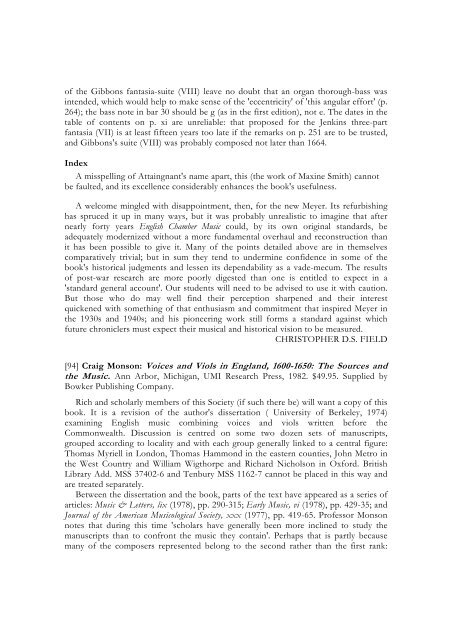Create successful ePaper yourself
Turn your PDF publications into a flip-book with our unique Google optimized e-Paper software.
of the Gibbons fantasia-suite (VIII) leave no doubt that an organ thorough-bass wasintended, which would help to make sense of the 'eccentricity' of 'this angular effort' (p.264); the bass note in bar 30 should be g (as in the first edition), not e. The <strong>da</strong>tes in thetable of contents on p. xi are unreliable: that proposed for the Jenkins three-partfantasia (VII) is at least fifteen years too late if the remarks on p. 251 are to be trusted,and Gibbons's suite (VIII) was probably composed not later than 1664.IndexA misspelling of Attaingnant's name apart, this (the work of Maxine Smith) cannotbe faulted, and its excellence considerably enhances the book's usefulness.A welcome mingled with disappointment, then, for the new Meyer. Its refurbishinghas spruced it up in many ways, but it was probably unrealistic to imagine that afternearly forty years English Chamber Music could, by its own original stan<strong>da</strong>rds, beadequately modernized without a more fun<strong>da</strong>mental overhaul and reconstruction thanit has been possible to give it. Many of the points detailed above are in themselvescomparatively trivial; but in sum they tend to undermine confidence in some of thebook's historical judgments and lessen its depen<strong>da</strong>bility as a vade-mecum. The resultsof post-war research are more poorly digested than one is entitled to expect in a'stan<strong>da</strong>rd general account'. Our students will need to be advised to use it with caution.But those who do may well find their perception sharpened and their interestquickened with something of that enthusiasm and commitment that inspired Meyer inthe 1930s and 1940s; and his pioneering work still forms a stan<strong>da</strong>rd against whichfuture chroniclers must expect their musical and historical vision to be measured.CHRISTOPHER D.S. FIELD[94] Craig Monson: Voices and Viols in England, 1600-1650: The Sources andthe Music. Ann Arbor, Michigan, UMI Research Press, 1982. $49.95. Supplied byBowker Publishing Company.Rich and scholarly members of this <strong>Society</strong> (if such there be) will want a copy of thisbook. It is a revision of the author's dissertation ( University of Berkeley, 1974)examining English music combining voices and viols written before theCommonwealth. Discussion is centred on some two dozen sets of manuscripts,grouped according to locality and with each group generally linked to a central figure:Thomas Myriell in London, Thomas Hammond in the eastern counties, John Metro inthe West Country and William Wigthorpe and Richard Nicholson in Oxford. BritishLibrary Add. MSS 37402-6 and Tenbury MSS 1162-7 cannot be placed in this way an<strong>da</strong>re treated separately.Between the dissertation and the book, parts of the text have appeared as a series ofarticles: Music & Letters, lix (1978), pp. 290-315; Early Music, vi (1978), pp. 429-35; andJournal of the American Musicological <strong>Society</strong>, xxx (1977), pp. 419-65. Professor Monsonnotes that during this time 'scholars have generally been more inclined to study themanuscripts than to confront the music they contain'. Perhaps that is partly becausemany of the composers represented belong to the second rather than the first rank:
















